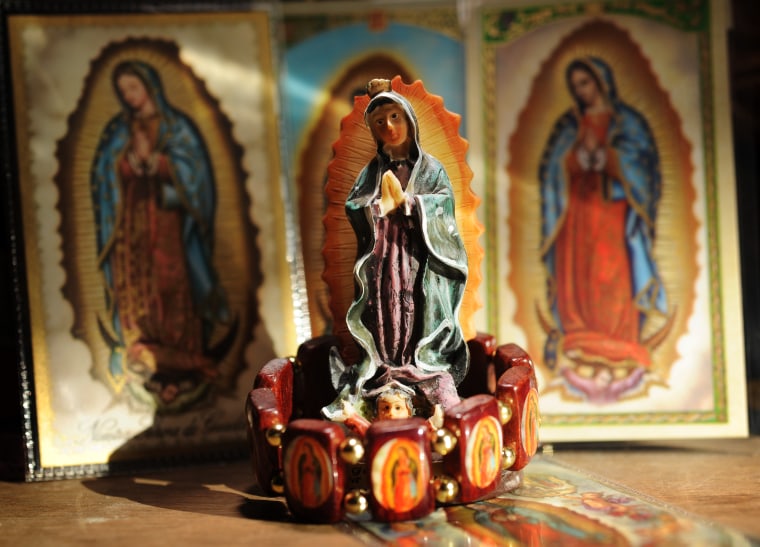On December 12, I think back to when I was a kid and my Aunt Emma lived with us. Late at night when I couldn’t sleep, I would sneak into her room and sit at the foot of her bed while she told me stories. Aunt Emma was my spiritual Scheherazade, spinning tales of miracles that happened in far-off places like Lourdes and Fatima. My favorite one was about Our Lady of Guadalupe, because it was better than a ghost story and my aunt swore it was all true.
As Aunt Emma explained it, Our Lady of Guadalupe became the patron saint of Mexico by appearing to a poor Mexican Indian named Juan Diego on December 12th, a long, long time ago. “She could have appeared to anyone, anyplace,” Emma pointed out, “but she chose one of us, because God knows we have the best faith.”
“We listen to Our Lady,” my aunt said proudly, “so she loves us the best.”
While my aunt used to refer to Our Lady of Guadalupe as “Our Lady,” to me she was just That Lady. I saw That Lady on murals all over East L.A., and on a picture at my grandpa’s house in El Paso. Her image adorned a calendar from our favorite bakery. That Lady was on pendants worn by senior citizens, and on tattoos on the biceps of the local cholos. That Lady, I recall thinking, really got around.
Seeing her inspires a spark of realization that wherever she is, there are likely 'mexicanos.'
Back then, I liked Our Lady of Guadalupe for the simple reason that she was instantly recognizable. Unlike God, who try as I might, I had a hard time visualizing, Our Lady of Guadalupe had a clear and fixed image. She was always shown as looking down slightly to the right, with an angel at her feet. She stood with rays of light all around her, and she wore a turquoise cape with stars on it. In moments of boredom at catechism class, I used to scrutinize her Mona Lisa countenance and try to figure out her expression. Depending on how long I stared at her, she could seem sad, thoughtful, strong, or loving.
I enjoyed the story of Guadalupe because, in some ways, it seemed relatable. As my aunt told it, Our Lady appeared to Juan Diego several times, but he missed her once because his uncle was sick. Even at a young age, I knew that this was very Mexican, having family drama interfere with the rest of your life. Nor was it lost on me that, with her brown skin and dark hair, that Our Lady looked like the members of my Mexican-American family.
RELATED: Dance and Devotion: Matachines Tradition Honors Our Lady of Guadalupe
It wasn’t until I was an adult that I understood the enduring appeal of that "Lady” among Mexican-Americans. My aunt was right when she explained that the Virgin of Guadalupe was a source of pride for our people.
More than any other Latinos, Mexicans and Mexican-Americans feel an intense affinity for Our Lady of Guadalupe. While she is venerated throughout Latin America – she is known as “The Empress of the Americas” – Mexicans feel proprietary towards her.

I also know now that Our Lady of Guadalupe has captivated artists, writers, poets, activists, and scholars since her first appearance in 1531. The heroes of the Mexican Revolution carried her image on banners, as did Cesar Chavez and his United Farm Workers. More recently, she has inspired young people lobbying for immigration reform. She has been called everything from “the Mother of all Mexico” to a feminist icon.
For millions of Mexicans and Mexican-Americans, our Lady of Guadalupe remains a comforting, mysterious figure, an enigma upon whom we can project almost anything. She is both a sacred image and a symbol of everyday people.
Then there is the “proof” factor, which has always been important to a religious skeptic like me. Juan Diego supposedly asked Our Lady for proof of her appearance because his local priest did not believe that he had seen her. So she presented him with her cape, known as a tilma – which you can still see today in a basilica outside Mexico City. It remains one of the top tourist attractions in Mexico, attracting pilgrims and the curious from all over the world. It has been examined multiple times by scientists who have never conclusively accounted for its origins, nor for the fact that its colors have not faded over hundred of years. In 2009, a physicist who spent years researching the cape concluded that it was “outside science.”
These days, when I see Our Lady’s image, I feel a sense of recognition akin to seeing an old relative. Although I live across the country from my childhood home, “That Lady” is as ubiquitous as ever (The New York Times covered her reported image on a tree trunk in New Jersey in 2012). I’ve seen her in an alcove at St. Patrick’s Cathedral in Manhattan, and at a memorial for the undocumented workers who died on 9/11. I gasped at her appearance on a sequined jacket in the movie Legally Blonde. Seeing her inspires a spark of realization that wherever she is, there are likely mexicanos.
And every December 12th, as I observe the legions of the faithful thronging to special masses in Our Lady’s name, I am reminded of her hold on our community. For immigrant and assimilated Mexican-Americans alike, Our Lady of Guadalupe is part of our collective identity. Centuries ago she came to us – and we will never let her go.
